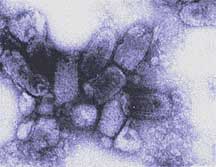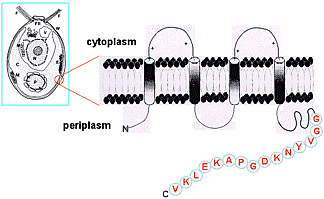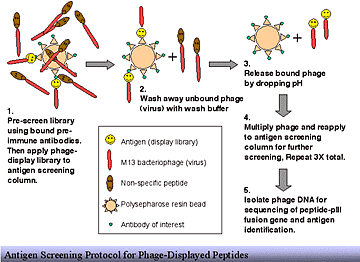 |
|||||||||
skip to content |
|||||||||
An Alga a Day Keeps the Doctor Away
Engineered Algae as a New Means to Vaccinate Fish
by Jill Jentes Banicki, Ohio Sea Grant Communications
![]()
"We realized if Chlamydomonas could bind to heavy metals so effectively, why couldn't it be used to deliver needed vitamin supplements or a vaccine to an animal?" asks Sayre.
![]()
|
Ohio Sea Grant research is developing a vaccine to protect fish from IHNV, a viral disease that kills 30 percent of the U.S. trout population. |
When Ohio Sea Grant researcher Dr. Richard Sayre of Ohio State University started his research on engineered algae 10 years ago, his focus was on bioremediation methods. Chlamydomonas reinhardtii, a unicellular alga found abundantly all over the world, could be genetically altered to recover harmful heavy metals locked in sediments. Over the years, he has been able to enhance its binding capabilities, resulting in a significant step toward remediation of contaminated sites and waters of the Great Lakes.
But recently, his scope has broadened. "We realized that if Chlamydomonas could bind to heavy metals so effectively, why couldn't it be used to deliver needed vitamin supplements or a vaccine to an animal?" asks Sayre.
Sayre along with Dr. Richard Wagner expanded their research to see if the mircoalgae could be used as a way to vaccinate fish for Infectious Hematopoietic Necrosis Virus (IHNV), a viral disease that kills 30 percent of the U.S. trout population.
|
Chlamydomonas cell with antigen for bacterial kidney disease: A unicellular alga found abundantly all over the world could be an effective means to deliver vaccines to fish. By attaching the correct antigen to the outside of the Chlamydomonas cell, the algae can be fed to the fish and induce an immune response to the disease. Larger view |
Controlling fish diseases has long been a problem for the aquaculture industry, adds Sayre. Antibiotics are not only useless for viral and many parasitic diseases, but they can only be partially absorbed by fish. Although fish vaccines are a more successful alternative, they can be costly, labor intensive, and stressful for the fish.
|
"When fish (that are fed the algae) express antibodies against the antigen bound to the algae, we'll know this approach works, and we'll extend it toward other diseases," states Sayre. |
"Unfortunately, the trouble with producing many vaccines is you need to identify the pathogen and then you need time to culture it," explains Sayre. "Our system doesn't require either." Using a peptide library of all the possible amino acid combinations displayed on the surface of a virus (called a combinatorial phage display library), Sayre's team can rapidly screen for antigens using pathogen-specific antibodies. The screening process involves binding antibodies from a sick fish to polystyrene beads (see Figure below). Antibody-binding peptides from the library are then bound to the beads via the antibody. After the beads are washed to remove loose phage, the tightly bound phages are specifically released and (viruses) reapplied to the beads, washed and released repeatedly for several rounds of purification. "When the antigen is isolated by the screening process, we compare it to the known IHNV genome and known antigenic determinants to see if the process produced a viable antigen," states Sayre. His research has found a tentative antigenic peptide.
|
Before a vaccine can be attached to the algal cell, an antigen for the virus first needs to be isolated. Sayre is using a combinatorial phage display library, to screen for peptides that bind to antibodies obtained from sick fish. The candidate antigens may be used for future vaccine trials. Larger view |
Sayre and his team plan to test those antigens by conducting vaccine trials later this year through Sayre and Wagner's company, Phycotransgenics. The antigens will be attached to the outside of the Chlamydomonas cell, which will in turn be delivered to the fish through either food or immersion (water). "When fish (that are fed the algae) express antibodies against the antigen bound to the algae, we'll know this approach works, and we'll extend it toward other diseases," states Sayre. A patent is currently pending for this microalgal antigen delivery system.
For more information about this Ohio Sea Grant funded project, contact Dr. Sayre at sayre.2@osu.edu or visit his web site at www.biosci.ohio-state.edu/~plantbio/Faculty/sayre.htm. For a related article about his heavy metal bioremediation research, see Twine Line's Sept/Oct 2001 issue at www.sg.ohio-state.edu.
|
Ohio Sea Grant works to increase understanding, assessment, utilization, development, conservation, and stewardship of our Great Lakes and ocean resources, with particular emphasis on Lake Erie. Using a combination of research, education, and outreach, Ohio Sea Grant partners with academia, government, and the private sector to focus on the economy, environment, and education. The Ohio Sea Grant College Program is one of 30 programs in the National Sea Grant College Program of the National Oceanic and Atmospheric Administration (NOAA), Department of Commerce. Ohio Sea Grant is supported by NOAA, the Ohio Board of Regents, The Ohio State University, industries, and associations. |
[12/15/03]
CLIMATE · OCEANS, GREAT LAKES, and COASTS · WEATHER
and AIR QUALITY
ABOUT US · RESEARCH
PROGRAMS · EDUCATION · HOME


